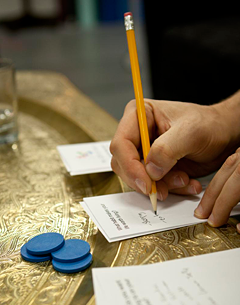47 Questions, unlimited answers
 One of the things you figure out pretty quickly when you’re dealing with end-of-life issues is that nothing is simple. Even a highly detailed Advance Directive can’t predict all of the possible situations that a person and their family are likely to have to manage, and even if they could, things change. And they change quickly.
One of the things you figure out pretty quickly when you’re dealing with end-of-life issues is that nothing is simple. Even a highly detailed Advance Directive can’t predict all of the possible situations that a person and their family are likely to have to manage, and even if they could, things change. And they change quickly.
So when we set out to design a set of questions for My Gift of Grace, we wanted to cover a lot of ground, but we didn’t try to draw a complete map. Rather than getting into detail about situations most of us haven’t encountered yet, we included two kinds of questions that are meant to start conversations.
The first are oblique. These are questions that come in from an odd angle, like “What are you no longer embarrassed about?” At first glance, they might not seem to be relevant to end-of-life issues, but they reveal our underlying values – the things that guide our decisions.
The second are specific, such as “What would you like done with your body after you die?” These questions often have clear timeframes or other restrictions that focus a player’s answers, asking them to be as precise as possible. Questions like this put us in a concrete frame of mind and put our values to the test.
Surprisingly, both types of questions are meant to elicit the same kinds of answers: stories. Stories are what we make meaning with, they’re our guide to the world we’ve moving through. The stories we tell help us see how we understand the world, and by telling them to other players, we reveal our values.
Hundreds of questions were considered for the game, and the ones that made the final cut are the ones that evoked stories in test games. They’re the ones that surprised us, the ones that people answered by going off topic or shedding light on something we hadn’t anticipated.
There are as many different answers to the questions about what people want at the end of their lives as there are people on the planet, so rather than trying to ask questions that directly prompt all of those answers, the game asks questions that make room for people to fill with whatever they need to say. In this way, the game is platform that allows groups of people to build the conversation they need.
- Nick Jehlen's blog
- Log in to post comments

